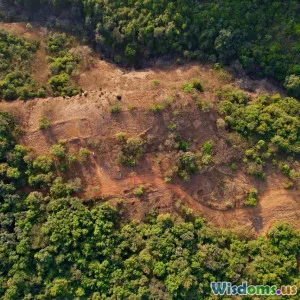
The Importance of Biodiversity for a Sustainable Future
8 min read Explore how biodiversity underpins a sustainable future, vital for ecosystem health, climate resilience, and human well-being. (0 Reviews)
The Importance of Biodiversity for a Sustainable Future
Introduction
Imagine a world stripped of the vibrant variety of life — no birdsong at dawn, no rustling leaves, no thriving coral reefs swirling with colorful fish. Such a world is hard to picture but arguably closer to reality than we’d like to believe due to accelerating biodiversity loss. Biodiversity, the immense variety of life on Earth including plants, animals, fungi, and microorganisms, is not just nature’s decoration; it is the backbone of ecosystems and a silent guarantor of our planet’s health and resources.
Understanding biodiversity’s vital role is key to securing a sustainable future for all. Why? Because the variety of life forms underpins ecosystem functions that provide clean air, fresh water, fertile soil, and climate regulation. As threats from habitat destruction, climate change, pollution, and invasive species compound, preserving biodiversity isn't just an option — it's imperative for survival.
This article dives deep into why biodiversity matters, exploring its benefits to ecosystems, human societies, and the global economy. We will also examine practical conservation strategies to safeguard biodiversity for coming generations.
The Pillars of Biodiversity’s Importance
1. Ecosystem Stability and Resilience
Biodiversity equips ecosystems with resilience — their ability to withstand disturbances and recover. Diverse ecosystems contain multiple species that fulfill similar roles. If one species disappears, others can compensate, maintaining overall ecosystem functionality.
For example, a forest that hosts numerous insect pollinators ensures continued plant reproduction, even if some pollinator species decline. Similarly, keystone species such as wolves in Yellowstone maintain trophic balance, preventing overgrazing and preserving vegetation.
Multiple scientific studies show that species-rich ecosystems are more productive and stable. A landmark 2015 study published in Nature demonstrated that plant species diversity increases carbon storage, which is crucial for climate regulation.
2. Climate Change Mitigation
Biodiversity plays a pivotal role in buffering climate change effects. Forests, wetlands, and oceans act as massive carbon sinks, absorbing about half of the CO2 humans emit. Healthy and biodiverse forests store carbon more efficiently as varied species grow at differing rates, depths, and carbon capacities.
Mangroves, coral reefs, and seagrasses also protect shorelines from storm surges and erosion. The loss of these ecosystems due to biodiversity degradation would accelerate climate impacts on vulnerable communities.
3. Food Security and Agricultural Sustainability
The future of global food security hinges on biodiversity. Diverse crop species and genetic variation underpin adaptive potential to pests, diseases, and changing climate conditions. For instance, traditional seed banks conserve the genetic material necessary to breed resilient crop varieties.
Beyond crops, biodiversity ensures ecosystem services critical to food production: pollination, nutrient cycling, and soil health. According to the Food and Agriculture Organization (FAO), approximately 75% of the world's food crops rely at least in part on animal pollination.
4. Economic and Medicinal Value
Biodiversity significantly contributes to economies worldwide. The global nature-based tourism industry, valued at around $600 billion annually, depends on rich natural environments. Industries like pharmaceuticals rely heavily on natural compounds extracted from myriad species.
For example, the cancer drug Paclitaxel (Taxol) was originally derived from the Pacific yew tree. Countless other medicines depend on biodiversity, many yet undiscovered. Protecting biodiversity means preserving untapped resources vital for future innovations.
Pressing Threats to Biodiversity
In the Anthropocene, human activities are the primary drivers of biodiversity loss. Key threats include:
-
Habitat Destruction: Urbanization, deforestation, and agricultural expansion fragment or eliminate ecosystems. The Amazon rainforest, home to an estimated 10% of known species, has lost about 17% of its area in the last five decades.
-
Climate Change: Altered temperature and precipitation patterns disrupt species’ habitats and migration.
-
Pollution: Chemicals, plastics, and waste degrade habitats and poison wildlife.
-
Invasive Species: Non-native species outcompete, prey upon, or bring diseases to native species.
Alerts from organizations like the WWF's Living Planet Report 2022 indicate an average 68% population decline among monitored vertebrate species since 1970, underscoring the urgency of conservation.
Effective Strategies to Preserve Biodiversity
Protected Areas and Habitat Restoration
Establishing national parks, marine reserves, and wildlife corridors has proven effective. Costa Rica, for instance, reversed deforestation trends by designating over 25% of its territory as protected and engaging local communities.
Restoring degraded landscapes — through reforestation or wetland rehabilitation — enhances biodiversity and ecosystem services. Techniques like rewilding, which reintroduce native species, restore ecological balance.
Sustainable Practices in Agriculture and Industry
Adopting agroecological methods — crop rotation, polycultures, reduced pesticides — supports farm biodiversity while maintaining yields.
Corporate operations must also minimize ecological footprints. Supply chain sustainability standards encourage sourcing from biodiverse-friendly environments.
Community Involvement and Indigenous Knowledge
Indigenous peoples manage lands that harbor significant biodiversity. Integrating their traditional knowledge with modern science improves conservation outcomes.
Connecting local communities as custodians ensures sustainable resource use and social equity, such as community forestry initiatives in Nepal that enhanced forest cover and rural livelihoods.
Global Cooperation and Policy Frameworks
International agreements like the Convention on Biological Diversity (CBD) aim to halt biodiversity loss. The recent post-2020 Global Biodiversity Framework sets ambitious targets to expand protected areas and restore ecosystems.
Robust policy enforcement and funding are critical to achieving these goals.
Conclusion: Biodiversity as a Cornerstone of Our Future
Biodiversity is not an abstract notion but a tangible foundation supporting life’s complexity and human prosperity. Its maintenance is crucial not only for natural beauty but for ecological balance, climate regulation, food provision, health, and economies.
Failing to act threatens catastrophic losses that are difficult, if not impossible, to reverse. Encouragingly, a combination of effective conservation, technological integration, community empowerment, and global commitment can protect and restore biodiversity.
As global citizens, recognizing biodiversity’s indispensable role and advocating for sustainable practices hold the key to nurturing a thriving planet.
The preservation of biodiversity is, unquestionably, safeguarding our own future.
“In nature, nothing exists alone.” – Rachel Carson
Rate the Post
User Reviews
Popular Posts

















